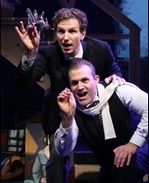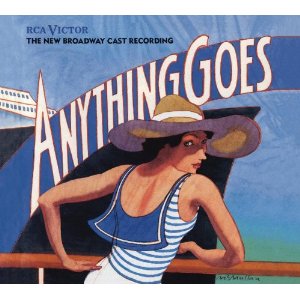SITE GUIDE
SEARCH
REVIEWS
REVIEW ARCHIVES
ADVERTISING AT CURTAINUP
FEATURES
NEWS
Etcetera and
Short Term Listings
LISTINGS
Broadway
Off-Broadway
NYC Restaurants
BOOKS and CDs
OTHER PLACES
Berkshires
London
California
New Jersey
DC
Philadelphia
Elsewhere
QUOTES
TKTS
PLAYWRIGHTS' ALBUMS
LETTERS TO EDITOR
FILM
LINKS
MISCELLANEOUS
Free Updates
Masthead
A CurtainUp Review
The Blue Flower
|
Why do you do this? — Mr. O I like putting things together. It’s not as easy as it looks. — Max |

Sebastian Arecelus and Marc Kudisch
(Photo credit: Ari Mintz) |
Staged as a living collage of human intimacy and abstracted expressionism, it was conceived and composed by married-to-each other collaborators Jim Bauer (music and lyrics) and Ruth Bauer (book). They have evidently been inspired by an expression coined by the German Romantic poets “to signify the ongoing search for artistic perfection,” and make it clear that their search has been rewarded. The Blue Flower is revelation of artistic resources and execution.
In collaboration with director Will Pomerantz, who has been with the show since it was produced by the American Repertory Theater in Cambridge, MA, in 2010 (following a developmental run by the Prospect Theatre Company in New York in 2008. The Bauers are to be commended for this beautiful musical theater piece. They are also to be thanked for giving us a little break/detour from such otherwise compelling/dominating subjects so far this season such as haranguing mothers, suicidal sons, agoraphobic daughters and demonic fathers.
Without any dysfunctional family members in view, The Blue Flower relies for its dramatic content on the wittily implemented lives, loves, and pursuits of three artists and one scientist, as provocatively suggested by such real-life characters from the early part of the 20th century as German expressionists Max Beckman and Franz Marc, the German Dada artist Hannah Höch and the Nobel Prize-winning physicist/chemist Marie Curie. It is, however, their whimsically and wittily re-imagined selves who emerge as ghosts and are identified (as well in the program) only by their first names Max (Marc Kudisch), Franz (Sebastian Arcelus), Hannah (Meghan McGeary) and Maria (Teal Wicks). It's left to the stunning film footage and the projections design (the work of the Bauers and Aaron Rhyne) to establish their implied link to their real-life counterparts, as well as to the times, places, and eras in which the musical takes place.
The story evolves as a romanticized but also tumultuous series of escapades that span fifty years and two continents — starting with the Belle Époque and continuing into the era between the two World Wars that embraced the artistic, socialist, and political indulgences of the Weimar Republic and Dada movement.
The story begins in the mind of Max (Kudisch) as he falls over dead while sitting on a park bench in New York in 1955. A victim of a fatal heart attack, Max is adding to his own book of “fairy tales,” a collage of saved bits and pieces of a life shared with friends and lovers. Resurrection isn’t easy, but we are glad for its potential as Kudisch is about to keep us in his thrall as he delivers the kind of dynamic, impassioned and riveting performance that will surely be among the most memorable of the season. This, despite the fact that some of his speech is spoken in Maxperanto, a language of his own devising that proves no barrier to communication.
The musical moves forward by a narrative thread mostly, but not always, in the hands of a mysterious Mr. O (Graham Rowat) who remains a constant figure. Also constant is our increasing understanding of Max and his relationship with his dearest and closest friend Franz (Sebastian Arcelus) and his lover Maria (Teal Wicks), as well as with Hannah the artist who will not only become the love of Max’s life but his partner in art.
What a passionate closely-knit group they are. Max, with his obsession for collage, and Franz, with his artistic focus on cowboys and horses, have been friends and roommates since they met at art school in Berlin in 1913. The dashing Franz and the lovely and brilliant Maria become an item, as do Max and Hannah. Franz and Maria are seen groping with lust just as Max and Hannah are seen grappling with the political and social changes going on around them as well as becoming activists within the revolution in the art world.
The canvas upon which these lives are depicted is sprawling, but the narrative and the action is always clear. More importantly, under the elegant direction of Will Pomerantz, it is lively and bracing. There is, in fact, a real canvas, as well as a large drop cloth upon which are projected images of Paris, Zurich, and Berlin. Beowulf Boritt has designed an amazing towering set— multi-level, wooden scaffolding with bridges, stairs, ladders, wheels and pulleys. It looms on a stage of wooden planks where a large moveable square table serves when needed as a performing stage.
Although the costume designer Ann Hould Ward’s pallet is dominated by black and white, the peripheral visual elements use color for effect. I was equally impressed by the eclectic score that provides a lilting but also liberating emotional resonance to the characters. The musical apparently grew out a song-cycle, but the songs are so organically integrated that they sound like involuntary examples of expressionism in their own right.
The program does not list the various musical numbers, but each aria/song/instrumental fragment responds to the character or the moment with either a burst of American country music or a bow to German Weimar Republic cabaret with a dash of Kurt Weill thrown into the mix. Pomerantz’s direction/staging, enhanced by the choreography of Chase Brock, serves both the passive and the passionate sections of the musical. The scenes of war, including Franz’s death on the battlefield, are as disturbing and vivid as is the decadent, liqueur and cocaine party that serves to fracture the relationship between Max and Hannah. (Note: The 2008 Prospect Theatre production did list the songs and while there have been some changes, mostly in the order of presentaton. To see that equally enthusiastic review and the song list go here).
Although there is an irrefutable bridge of expressionism that defines the mise-en-scène of this adventurous musical, there is a decided homage paid by the design team to Hõch to incorporate her Dada-influenced style particularly as a creator within the collage and photomontage school of graphic art. As Hannah, McGeary makes a formidable impression with her singing, as well as with her flamboyant turns as a Dada-ist performer in the famed Cabaret Voltaire in Zurich where Dada began. McGeary’s performance as Hannah is a heady a display of an independent soul. In contrast is Wicks’s more poignant Maria, who is haunted by the memory of her lover killed in the war.
The extraordinary way that Bauers and their collaborators have literally, figuratively and symbolically configured life, love, and art into a stunningly expressionistic musical collage is quite a feat, one that gives their musical it’s most notable distinction.,
|
The Blue Flower Music and lyrics by Jim Bauer. Book by Jim and Ruth Bauer. Directed by Will Pomerantz Choreographed by Chase Brock Sebastian Arcelus (Franz), Marc Kudisch (Max), Meghan McGeary (Hannah), Joseph Medeiros (Typewriter Man), Julia Osborne (Gramophone Girl), Graham Rowat (Mr. O), Aaron Serotsky (Sewing Machine Man) and Teal Wicks (Maria). Scenic design: Beowulf Boritt Costume design: Ann Hould-Ward Lighting design: Donald Holder Sound design: Dan Moses Schreier Projection design: Aaron Rhyne From 10/27/11; opening 11/09/11; closing 11/27/11. Running Time: 2 hours 25 minutes including intermission Second Stage, 305 W 43rd Stt Ticket Price: $80.00; Senior $72.00; Youth Advance $30.00; Student RUSH $18.00. Tuesday & Sunday 7:00pm, Wed to Sat 8:00 pm, Sat and Sun at 2pm Reviewed by Simon Saltzman based on November 8th pressperformance |
|
REVIEW FEEDBACK Highlight one of the responses below and click "copy" or"CTRL+C"
Paste the highlighted text into the subject line (CTRL+ V): Feel free to add detailed comments in the body of the email. . .also the names and emails of any friends to whom you'd like us to forward a copy of this review. Visit Curtainup's Blog Annex For a feed to reviews and features as they are posted add http://curtainupnewlinks.blogspot.com to your reader Curtainup at Facebook . . . Curtainup at Twitter Subscribe to our FREE email updates: E-mail: esommer@curtainup.comesommer@curtainup.com put SUBSCRIBE CURTAINUP EMAIL UPDATE in the subject line and your full name and email address in the body of the message. If you can spare a minute, tell us how you came to CurtainUp and from what part of the country. |
 Anything Goes Cast Recording
Anything Goes Cast RecordingOur review of the show
 Book of Mormon -CD
Book of Mormon -CDOur review of the show

Slings & Arrows-the complete set
You don't have to be a Shakespeare aficionado to love all 21 episodes of this hilarious and moving Canadian TV series about a fictional Shakespeare Company

